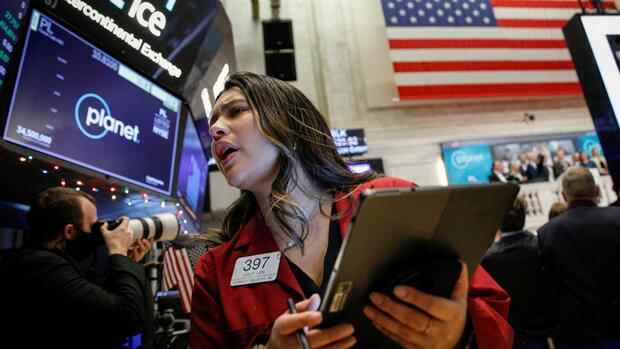This movement then continued through Asia to Europe, but Wall Street stabilized again on Thursday. The shock sits deep in the investors’ bones. “Only now have the markets understood that the Fed will probably want to reduce its total assets relatively quickly,” explains Keller. There were hints in this direction before, but the message only got through with the Fed protocol. Some central bankers noted that a cut might be appropriate relatively quickly after the rate hikes start.
“The rules for rising interest rates obviously have to be dug up again”, says Ulrich Kater, chief economist at the Sparkasse fund subsidiary Deka. “They disappeared in the drawer for a long time, were not needed.”
Kater believes the turnaround in interest rates is “healthy and necessary for the markets” so that valuations can find a basis again. “The upcoming withdrawal of liquidity will initially have a dampening effect on the stock markets – because the positive correlation between the share price level and liquidity has an effect here,” explains Kater.
Top jobs of the day
Find the best jobs now and
be notified by email.
That could lead to temporary price setbacks in the order of magnitude of around five percent. The US bank Goldman Sachs points out, however, that Europe tends to have fewer such highly valued stocks and could therefore even benefit relative to the USA.
Like many economists, Kater expects inflation to decline in Europe and the United States. In his opinion, the yield on ten-year US Treasuries will increase to 2.5 percent by 2024. It jumped to 1.7 percent on Wednesday.
However, the increase could quickly be slowed down again if major Asian investors enter the market, says Keller. The entry will also be interesting for Europeans.
With the federal bond, which has already reacted clearly to the events in the USA, Kater anticipates a fluctuation range between minus 0.2 and plus 0.3 percent, with an upward trend. He emphasizes: “The inflation trend is the key for the capital market development in the next few years.”
Hangover remains optimistic for the stock markets: A still non-existent real interest rate and a solid economic foundation should continue to support the stock markets, he says. He grants the Dax an increase of eight percent in 2022, the US S&P 500 index around four percent.
New normal in the markets
The Fed has been driving the economy for years with low short-term interest rates and bond purchases. Now it has to fight inflation, which has risen to almost seven percent. Since Wednesday it has now been clear that it is pulling the reins a little more in the long-term than expected, but a little less in the short-term. The US Federal Reserve is likely to start shrinking again soon after holding back balance sheet growth in the spring.
In other words: after it no longer purchases any more bonds on a net basis, it will relatively quickly no longer replace all expiring papers, so that the portfolio will decrease. So far, most observers had expected that this meltdown, as in similar earlier situations, would only begin after the central bank had already significantly increased short-term interest rates.
Fed Governor Christopher Waller had already indicated a faster meltdown in December. He spoke out in favor of reducing the Fed’s holdings of securities from currently 35 percent of US gross domestic product to around 20 percent. James Bullard, head of the St. Louis regional Fed, had also mentioned shrinking. However, neither of them had yet caused a major market reaction.
The consequence of the Fed’s strategy is that the yields on long-term bonds are no longer depressed as much by monetary policy. At the same time, the Fed may be able to take a little more time to raise short-term interest rates. “The Fed obviously wants to avoid a yield curve that is too flat,” predicts Keller.
One reason for this could be that it has the stability of the financial system in mind. Because the money houses live partly from the fact that they take in money in the short term and lend it in the longer term. However, this maturity transformation only works if the yield gap between short and long is large enough.
The US bank JP Morgan also points out that the Fed would probably have to write losses itself if it pushes up short-term yields faster than long-term ones – because it pays interest to the banks on the cash reserves they hold with it. That would not be a problem economically, because the goal of the central banks is not to make a profit. But it would look bad politically.
Diane Swonk, Grant Thornton’s chief economist, sees an important admission in the Fed minutes. It reflects “a subliminal fear or panic,” she wrote on Twitter.
Fed Chairman Powell managed to tighten monetary policy in December without scaring the markets. At the same time, however, it did not seem clear enough how concerned US monetary policymakers actually are about rising inflation. For months, prominent economists such as Mohamed El-Erian, who also advises Allianz, and ex-Treasury Secretary Larry Summers have been warning that the Fed is not taking inflation seriously enough.
What the Fed does has an impact around the world. “It is now getting complicated for the European Central Bank (ECB),” fears Keller, “the development in the euro area and that in the USA are diverging ever further.” the balance sheet total.
However, the reaction of the bond markets has shown that Europe is allowing itself to be infected by the US. Keller fears: “It is possible that highly indebted countries like Italy will now get higher yields solely through the influence of the Fed.”
More: Up to 79 percent price potential: According to analysts, these ten stocks will continue to rise in 2022.

